- Yokohama-shi Top Page
- Kanazawa Ward Top Page
- Introduction of the ward
- History of Kanazawa Ward
- Yokohama Kanazawa, where history lives
- Kanazawa unraveled from the scenery
- Mud Kame Nitta and Coastal Landfill
Here's the text.
Mud Kame Nitta and Coastal Landfill
Last Updated November 6, 2020
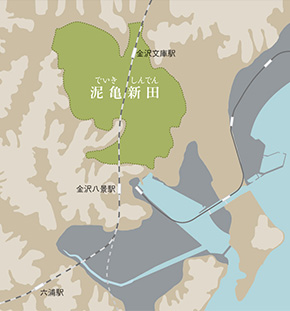
In the Edo period, many Nitta developments took place.
In Yokohama, the development of Yoshidashinden (now Naka Ward and Minami Ward), which was reclaimed inland seas in the early modern period, is well known, but at the same time Kanazawa also reclaimed Hiragata Bay.
Until the beginning of the early modern era, the sea was intricate toward Kanazawa to the inn in Kamariya and the Rokuura area near Kodenji Temple, and the current ward office, police department and Kanto Gakuin University were in the sea.
Landfill in the Rokuura area is difficult to back up historical materials, but it is known that the Kanazawa area was promoted by Yuaki Nagashima, a Confucian official of Edo Yushima Seido Temple.
The three villages, Hashikawa, Hiragata, and Irie Nitta, which were reclaimed by the Nagashima family for about 200 years, are named mud turtle Nitta after taking from Yuaki Nagashima's mud turtle and become a village.
History of Mudgame Nitta Development
| Christian era | Year | Major Events |
|---|---|---|
| 1668 | Kanbun 8 | Reclaim two locations: Hashikawa (currently part of Teramae 1-chome) and Hiragata (currently part of Hiragata-cho). |
| 1680 | Enpo era 8 | The tide embankment of Hashikawa and Hiragata Nitta opened by Yuhaku was damaged due to a typhoon |
| 1703 | Genroku era 16 | Due to the Great East Japan Earthquake, Hashikawa and Hiragata Nitta were damaged. He revived with Yuhaku's grandson Masahito 4th generation and his fifth generation brother Motoyoshi. |
| 1764~1780 | Meiwa-Yasunaga | The reconstruction of Nitta is planned. In addition to the two locations of Hashikawa and Hiragata, we plan to expand the Nitta landfill at Kanazawa Irie. |
| 1785 | Tenmei era 5 | Successful development of Kanazawa Irie Nitta |
| 1789 | Kansei Gen | "Kanazawa Irie Nitta" was flooded by a flood that hit the entire Kanto region in July. |
| 1791 | Kansei 3 | Inlet sluice gate was damaged due to high tides caused by a typhoon that hit Edo Bay. The tide embankment of the Nitta enclosure flows out and enters the sea in the old days. |
| 1843 | Tenpo era 14 | The 9th Danemon Kamesu coordinates the return of mud turtle Nitta, but in response to opposition from surrounding villages, it developed into a lawsuit. |
| 1846 | Koka era 3 | Litigation was settled and construction began the following year |
| 1849 | Kaei era 2 | Reconstruction of Mudgame Nitta |
| 1851 | Kaei era 4 | Development of Hiragata Nitta and revival of Shiota |
| 1884 | Meiji 17 | The monument to Nagashima Kamesu is built on Nojima. |
The Nagashima family and the ward flower peony
In Kanazawa Ward, on October 18, 1993 (1993), a postcard vote from residents of the city selected "peony" as a flower of the city.
In Kanazawa Ward, the peony in the garden of the former Nagashima House, which was located on Nojima since the Edo period, was particularly famous.
In addition, Shintaro Ohashi, who acquired the land of the Nagashima family, took over Botanen from Nagashima's house in Nojima, planted Wakagi Senzo, and opened it to residents.
Until the early Showa era, 100 species of old trees and large flowers were blooming beautifully.
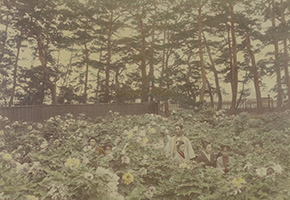
Botanen of the Nagashima family
(Nagao Kusuyama Collection, Kanazawa Bunko, Kanagawa Prefecture)
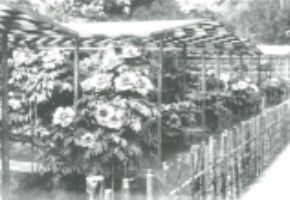
Botanen of the Ohashi family (provided by Nobuko Sakai)
The Nagashima Family and Ryukaji Temple
On the grounds of Ryukaji Temple (Susakicho), there is a tomb of the Nagashima Mudgame clan, a pioneer of Mudgame Nitta. The Nagashima family became the Danya of Ryukaji Temple and became deeply involved in successive Ryukaji Temples. In particular, Kiso Nagashima, who succeeded in developing mud turtle Nitta as Shiota, is committed to the revival of Ryuka Teramoto-do based on its financial strength.
Landfill and development of coastal areas
The Kanazawa Ward coast was reclaimed in the 1940s and 1950s as one of the six major projects in Yokohama announced in 1966.
Compared to before landfill, it can be seen that the conditions of the coastline and residential areas have changed significantly.
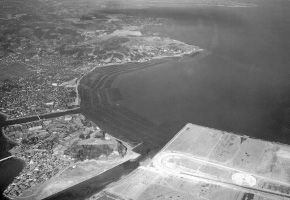
Kanazawa in the 1950s (Yokohama City History Archives)
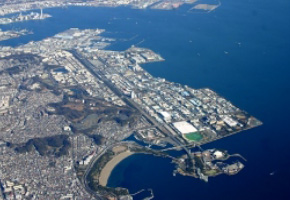
Today Kanazawa
Kanazawa Landfill Project
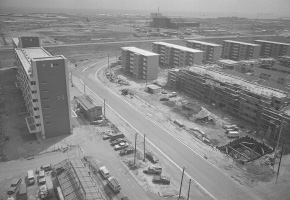
Housing construction in the Namiki district (Yokohama City History Archives)
The Kanazawa Landfill Project aims to cope with the rapid population increase due to overcrowding of cities, systematically promote the creation of a city that is in harmony with order, and aim for an excellent environment where all citizens can live happily. It was done.
At that time, Yokohama was following a trend toward weakening of urban functions due to population growth, with shops, housing, and factories in the city center disorderly.
Therefore, the city center was relocated to an ideal form as a business, commercial, and residential area, and the factory in the center was relocated to Kanazawa to eliminate the mixture of housing and engineering, and the aim was to be a livable and prosperous city. .
Inquiries to this page
Kanazawa Ward General Affairs Department Regional Promotion Division
Telephone: 045-788-7804
Telephone: 045-788-7804
Fax: 045-788-1937
Email address: kz-chishin@city.yokohama.jp
Page ID: 533-130-248













